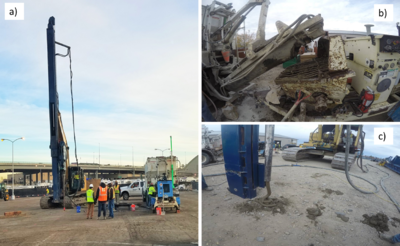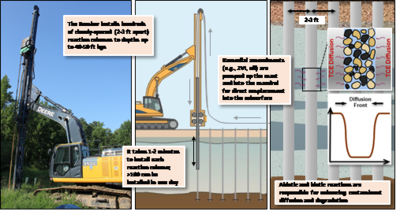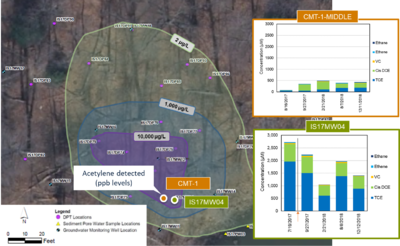User:Jhurley/sandbox
The persistent release of residual contaminants from low hydraulic conductivity (low k) zones prevents many chlorinated solvent sites from reaching groundwater cleanup goals. Low k aquifer settings limit the effectiveness of many conventional remediation technologies that rely on extraction, recirculation, or amendment delivery and distribution to achieve contact between the residual contaminants and the reagents, contact which is necessary for subsequent contaminant transformation or destruction. Alternative methods are needed to effectively distribute remedial amendments, to control contaminants leaving low k source zones, and to enhance natural attenuation processes. Two innovative remediation technologies for the treatment of chlorinated solvents and other contaminants in low k media are introduced, along with operational and performance results from recent field demonstrations.
Related Article(s):
CONTRIBUTOR(S):
Key Resource(s):
- The Horizontal Reactive Media Treatment Well (HRX Well®) for Passive In-Situ Remediation[1]
- The Horizontal Reactive Media Treatment Well (HRX Well®) for Passive In Situ Remediation: Design, Implementation, and Sustainability Considerations[2]
- New Application of A Geotechnical Technology to Remediate Low-Permeability Contaminated Media – Final Technical Report[3]
Introduction
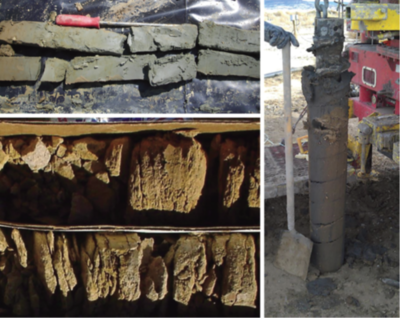
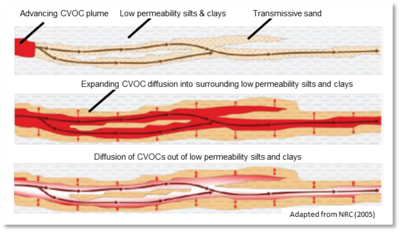
A critical challenge preventing many chlorinated solvent sites from achieving groundwater cleanup goals is the long term release of residual contaminants from low hydraulic conductivity (low k) zones such as silts, clays, glacial till, over-bank deposits, marine deposits, tailings “slimes”, saprolite and bedrock (see Figure 1)[4][6]. Such sites may be dominated by matrix diffusion processes (see Figure 2) which can significantly prolong restoration and site management timeframes. Residual contaminants residing in low permeability zones slowly diffuse from the low k matrix back into higher permeability zones, becoming a persistent source that is very difficult to remediate. One of the side effects of matrix diffusion is concentration rebound after an in situ treatment is applied. This is commonly observed at sites treated with chemical oxidation[7][8] and has the potential to occur at in situ bioremediation sites after the depletion of electron donors[9].
Currently, there are limited remediation options available to treat residual contamination trapped in low k zones. Low k settings limit the applicability and effectiveness of conventional remediation technologies due to the constraint on fluid introduction and recovery. As such, methods relying on extraction, recirculation, or reagent delivery and distribution are often limited in their effectiveness. For the long lived, difficult to treat sites, innovative technologies are needed that will reliably address mass flux limitations of contaminants leaving low k source zones, and also increase the actual treatment of the contaminants leaving these low k zones by enhancing natural attenuation processes. Two innovative technologies investigated by ESTCP are summarized below.
“Grout Bomber”
Technology Description
The geotechnical industry offers a variety of well-established techniques for quickly and efficiently accessing the subsurface for the purposes of ground stabilization, foundation rehabilitation, porewater drainage, and structural support. The speed and efficiency of these techniques can also be a major advantage for emplacement of remedial amendments into the subsurface. One promising approach is the Grout Bomber, a larger adaptation of conventional cement or compaction grouting techniques for subsurface stabilization. The technology uses an excavator equipped with specialized equipment (a “stitcher”) to quickly push a mandrel (3.5 in. diameter hollow cylindrical rod) into the subsurface and subsequently fill the hole and subsurface voids with cement grout (from bottom to top) using an in-line grout delivery system. The typical arrangement of the Grout Bomber technology includes the installation rig (excavator with the “stitcher” mast; see Figure 3a) and an on-site grout mixing and delivery unit consisting of mixing hopper, pumps, hosing, and power supply. Raw materials are loaded into the mixing hopper (see Figure 3b) where it is mixed to the appropriate consistency, then pumped to the Bomber rig at a rate of approximately 0.25 cubic feet per pump stroke. At the exit end of the Bomber mandrel (see Figure 3c), the grout flows in a continuous and uniform manner, allowing the columns to be emplaced with grout while the mandrel (which was pushed into the subsurface) is lifted to the surface. Hundreds of closely spaced vertical grout columns can be installed per day using this technology.
For environmental applications, the Grout Bomber approach can be “repurposed” as a means to improve delivery of remediation amendments into contaminated treatment zones in low k materials. The remedial amendment (e.g., mixture of zero-valent iron (ZVI), sand, neat oil) can replace the grout and be directly placed into the subsurface from bottom to top (not injected into the surrounding formation), creating hundreds of reaction columns. The Bomber technology offers the following benefits:
- Reduces uncertainty:
The Bomber technology circumvents the “delivery problem” associated with conventional injection-based remediation approaches, particularly in low k zones. The closely spaced nature of the reaction columns (2-3 ft spacing) reduces the diffusion lengths out of low k zones and also the uncertainty associated with amendment delivery because contaminants are always < 1 - 1.5 ft from an active treatment zone (see Figure 4).
- Rapid installation of reaction columns:
The Grout Bomber can install 100+ reaction columns per day to depths of 40-50 ft below ground surface (bgs) to encourage contaminant degradation in source zones. Since the Grout Bomber is a direct push technique, it is better suited to silts and clays with blow counts < 35. Consolidated materials with higher blow counts will require additional equipment to pre-drill the columns prior to amendment emplacement. In general, this technology represents a much simpler, less intensive, and easier to install version of complete soil mixing.
- Accommodates various amendment types:
In one example[3], vertical reaction columns containing a mixture of ZVI, vegetable oil, sand and minor amounts of water were installed to a depth of 30 ft bgs in a low k treatment area consisting primarily of silts, sandy clays, and lean clays[2]. The ZVI-sand-oil mixture was designed to have a similar consistency (or viscosity) to cement grout, thus requiring no major alterations to the existing Bomber equipment for the project. Recommended practices to ensure uninterrupted flow of amendments to the Bomber mandrel include:
- Conduct simple pumping pilot studies with amendments of varying consistencies,
- Consult with a well trained pump operator, and
- Minimize the length of hosing between mixing hopper pump and Bomber mandrel.
- Cost effective source zone treatment:
Estimated treatment costs associated with emplacement of amendments with the Grout Bomber are ~$35 per cubic yard of source zone treated (including contractor labor, equipment, and materials). This is generally less than the reported unit cost for in situ biodegradation ($20-$80/yd3) and significantly less than chemical oxidation ($125/yd3) and thermal remediation (median $200/yd3)[10].
Operational Approach & Results
A field demonstration was conducted at Site 17, Naval Support Facility Indian Head, Maryland. The treatment area consists primarily of silts, sandy clays, and lean clays with TCE concentrations in soil and groundwater of up to 250 mg/kg and 400 mg/L, respectively. Eight hundred reaction columns (consisting of ZVI/sand or oil/sand), were installed 2-3 ft apart, to a depth of 30 ft bgs at the site. Approximately 100 reaction columns were installed per day, with the most productive day totaling 180 columns. During operation, installation time for each reaction column was on the order of 1-2 minutes. Overall, 77,000 lbs of ZVI and 650 gallons of vegetable oil were emplaced within the source area of ~5,000 ft2.
Performance Results
Ongoing post installation monitoring of treatment area groundwater has found moderate reductions in TCE in site monitoring wells and that key degradation products that serve as indicators for both abiotic and biotic mechanisms (i.e., acetylene, ethene/ethane) are present. Samples from Continuous Multilevel Tubing (CMT) wells installed within reaction columns (anulus filled with ZVI amendment) have demonstrated 1-3 orders of magnitude reductions in TCE relative to the surrounding formation water (see Figure 5). These results provide evidence that the reaction columns are creating steep concentration gradients that could drive contaminants out of low permeability zones. Further, gaseous products (e.g., propane, propene, i-butane, n-butane, n-pentane, n-hexane) were detected in the unsaturated zone of several reaction columns further supporting abiotic TCE degradation. Results of this full scale project were very promising and, although several operational improvements were identified (e.g., improved pumpability of ZVI/sand mixture; minor equipment modifications; improved site prep practices), the Bomber technology has the potential to be an important remediation alternative for hard-to-treat chlorinated source zones, particularly ones with large, persistent matrix diffusion sources over large areas.
- ^ Divine, C. E., Roth, T, Crimi, M., DiMarco, A.C., Spurlin, M., Gillow, J., and Leone, G., 2018. The Horizontal Reactive Media Treatment Well (HRX Well®) for Passive In-Situ Remediation. Groundwater Monitoring & Remediation, 38(1), pp. 56–65. DOI: 10.1111/gwmr.12252
- ^ 2.0 2.1 Divine, C.E., Wright, J., Wang, J., McDonough, J., Kladias, M., Crimi, M., Nzeribe, B.N., Devlin, J.F., Lubrecht, M., Ombalski, D., Hodge, B., Voscott, H., and Gerber, K., 2018. The Horizontal Reactive Media Treatment Well (HRX Well®) for Passive In Situ Remediation: Design, Implementation, and Sustainability Considerations. Remediation, 28(4), pp. 5-16. DOI: 10.1002/rem.21571 Also available from: ResearchGate
- ^ 3.0 3.1 Richardson, S.D., Hart, D.M., Long, J.A., and Newell, C.J., 2020. New Application of A Geotechnical Technology to Remediate Low-Permeability Contaminated Media – Final Technical Report. ER-201627, Environmental Security Technology Certification Program (ESTCP). Project Overview
- ^ 4.0 4.1 Horst, J., Divine, C., Schnobrich, M., Oesterreich, R., and Munholland, J., 2019. Groundwater Remediation in Low-Permeability Settings: The Evolving Spectrum of Proven and Potential. Groundwater Monitoring & Remediation, 39(1), pp. 11-19. DOI: 10.1111/gwmr.12316
- ^ National Research Council, 2005. Contaminants in the Subsurface: Source Zone Assessment and Remediation. National Academies Press, Washington, DC, pp. 372. DOI: 10.17226/11146 Book.pdf
- ^ Sale, T., C. Newell, H. Stroo, R. Hinchee, and Johnson, P., 2008. Frequently Asked Questions Regarding Management of Chlorinated Solvents in Soils and Groundwater. Environmental Security Technology Certification Program (ESTCP) Project ER-0530, 38 pp. Report.pdf Project overview
- ^ McGuire, T.M., McDade, J.M., and Newell, C.J., 2006. Performance of DNAPL Source Depletion Technologies at 59 Chlorinated Solvent-Impacted Sites. Groundwater Monitoring & Remediation. Volume 26, Issue 1, pp. 73-84. DOI: 10.1111/j.1745-6592.2006.00054.x Free download.pdf
- ^ Krembs, F., Siegrist, R., Crimi, M., Furrer, R., and Petri, B., 2010. ISCO for Groundwater Remediation: Analysis of Field Applications and Performance. Groundwater Monitoring & Remediation, 30(4), pp. 42-53. DOI: 10.1111/j.1745-6592.2010.01312.x
- ^ Adamson, D., McGuire, T., Newell, C., and Stroo, H., 2011. Sustained Treatment: Implications for Treatment Timescales Associated with Source-Depletion Technologies. Remediation, 21(2), pp. 27-50. DOI: 10.1002/rem.20280
- ^ McDade, J.M., T.M. McGuire, and Newell, C.J., 2005. Analysis of DNAPL Source Depletion Costs at 36 Field Sites, Remediation, 15(2), pp. 9-18. DOI: 10.1002/rem.20039
